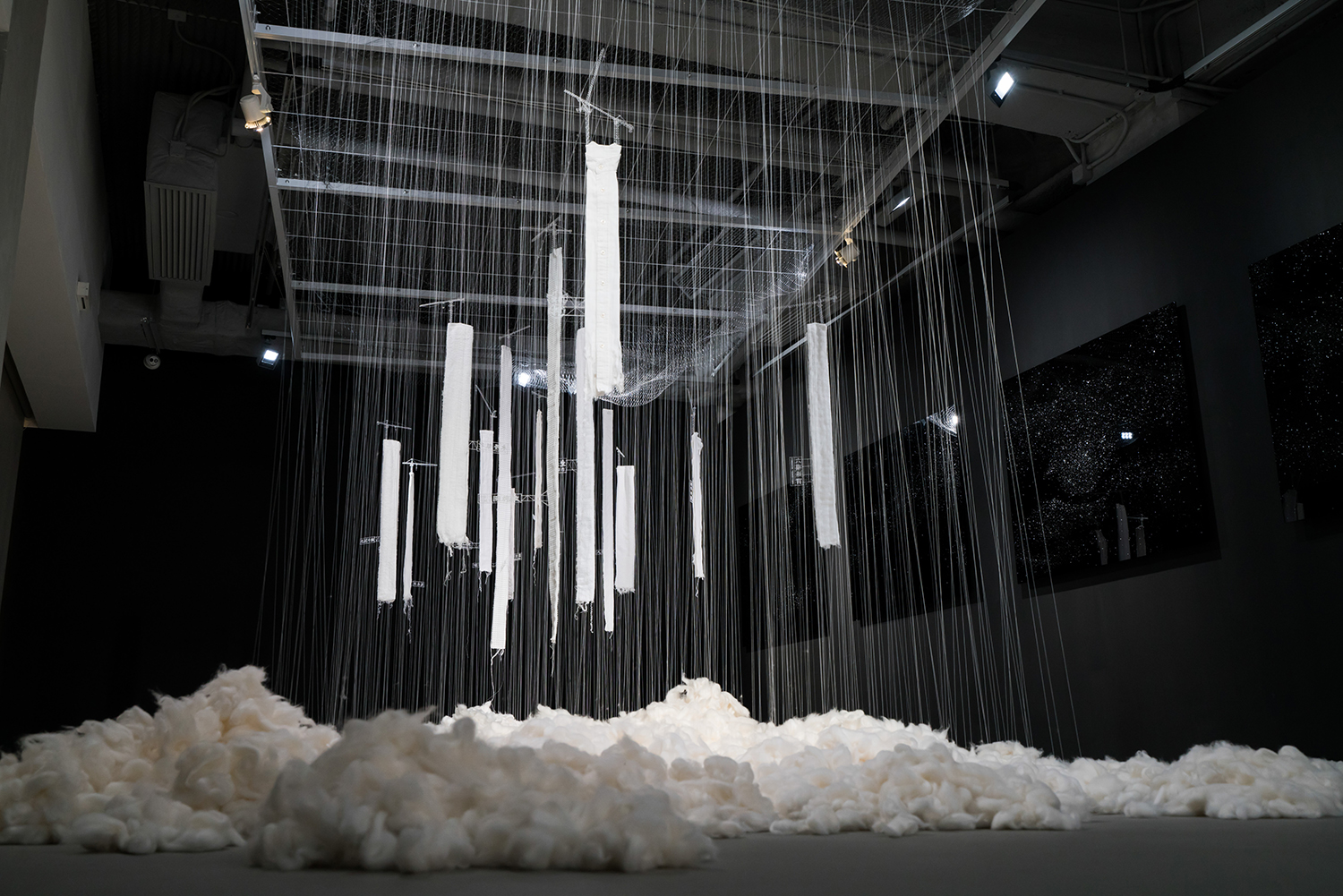Shows
Iwasaki Takahiro, Jung Yeondoo and Sarah Lai’s “(In)tangible Reminiscence”


Starting in the 1950s, Hong Kong, a former fishing village, transformed into the world’s factory for textiles, successfully oiling its machines for over four decades. As the industry thrived, then waned, the towers around the city rose ever higher, with brick and concrete making way for glass and steel. Now, what’s left of this industry, which altered the fates of so many citizens?
“(In)tangible Reminiscence,” presented by the Centre for Heritage, Arts and Textile—a newly established art institution that will fill the hull of an obsolete mill factory, slated to open in 2019—took this history as its departure point, prompting the works of three East Asian artists: Iwasaki Takahiro, Sarah Lai and Jung Yeondoo. In the Annex, a rented space in Central, the artists’ room-sized installations were thoughtfully displayed, each attempting to explore Hong Kong’s textile-driven past by revisiting personal and collective memories of migrants, workers and citizens.
Having experienced the transformation of Hong Kong first-hand, Lai introduced an intimate memory of Hong Kong’s fashion industry—namely the familiar scenario of shopping—that blossomed hand-in-hand with the growing number of textile factories in Kowloon, along with the rising middle class. Upon stepping into her dreamy habitat, titled Slide Through the Curtain of Night (2018), complete with a fitted carpet, hazy paintings of red-lipsticked women, a full-scale changing room and a rack of clothing, visitors may feel at ease with the unceremonious normality of the enveloping retail design. Yet, upon taking a closer look, the items appear noticeably dated: the grey fitted carpet, coarse and made of thin fibers, reminds us of old office floors; the curtains to the changing room hang drab in faded, sickly pinks, light greens and baby blues; the clothing on the rack feature contemporary cuts, but unfashionable patterns.
For those who recognize the set-up, which is steeped with visual cues alluding to the shopping experiences of the ‘90s, the work would hit close to home, perhaps evoking nostalgic memories. Ostensibly banal, Lai’s installation digs into the collective experiences of local citizens through a simulated setting of consumption—what was then a burgeoning experience of retail is now an integral part of Hong Kong’s economy.
In a curtained room, Jung’s installation, A Girl in Tall Shoes (2018), marries the oral stories of Hong Kong’s past and present by way of documentary, centering the narrative around the life of a former female textile factory worker. The work comprises two videos positioned side by side, screened simultaneously. One plays a recording of several young Hong Kong girls who walk amid the city’s urban landscape, responding out loud to seemingly random questions that prod at their interests, personal experiences and hardships.
One girl is asked about her relationship with her family, to which she answers: “[…] Actually, my family situation wasn’t so good when I was born and my dad didn’t earn so much. But he started to be more responsible and kept improving his professional skills to give me a better life.” When the girl falls silent, she stands as if listening intently at the second screen, which begins to make noise. The sound of a rapidly firing sewing machine fills the room, and we see an elderly hand deftly stitching traditional Chinese characters onto a piece of cloth: “I worked from 7am until 7pm. The wage was as low as HKD 3.00. I had to monitor big weaving machines. Six, eight machines. Later on, more than 20.”
From the writing, we gather that the sounding drill of the sewing machine and the embroidered texts together voice the account of the anonymous Hong Kong textile worker, and in a clever juxtaposition, we see an uncanny conversation unfurl between two women—one young, one old—posing a multinarrative space that turns orality into a static record of time transferred across generations. Surrounding the dual-video installation are the embroidered fabrics, as if to make tangible the worker’s experiences in the form of a visual diary.
Hong Kong’s history is divulged through a fictional landscape in Takahiro’s installation. Made of raw cotton, thread and fishing nets, the work echoes the city’s skyline, littered with construction cranes and world-famous neon signs. The fragments of towel and button-down shirts that float between the now-rare sightings of a fisherman’s net above, and a bed of fluffy cotton below, highlight how one of the world’s major economic centers has been built upon its history as a fishing village, and it’s once-booming textile industry. For the artist, who witnessed the rebuilding of his hometown, Hiroshima, after the catastrophic A-bomb detonation in 1945, our urban fabric is fleeting, sometimes scrapped and constructed anew.
Illustrating the countless lives that came together to forge the city’s spirit and visual culture, the three works by Takahiro, Jung and Lai, exist as an ode to Hong Kong’s industrial beginnings, but also act as a protest against the historical amnesia that may cause us to collectively erase the identities of our past generations.
Iwasaki Takahiro, Jung Yeondoo and Sarah Lai’s “(In)tangible Reminiscence” is on view at the Annex, Hong Kong, until April 22, 2018.







